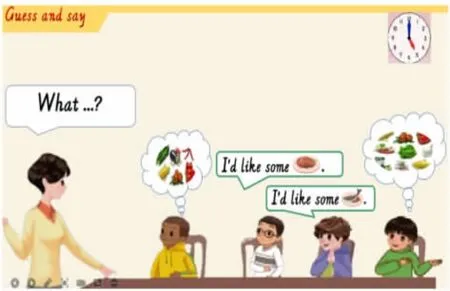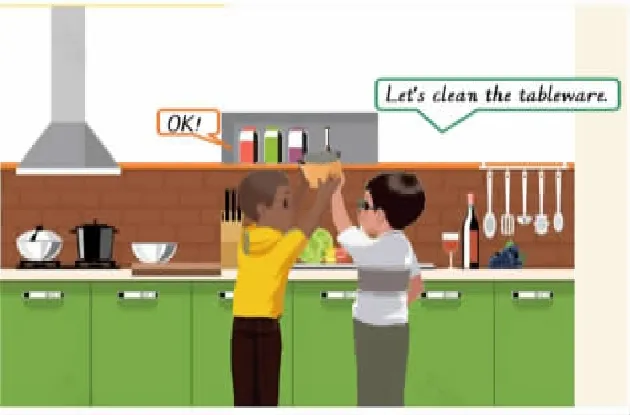PEP《英语》四(下)Unit 5 Dinner’s reday B Let’s learn
2022-06-06文|吴芳
文|吴 芳
教学过程
Step 1.Warming-up and revision
1.Enjoy a song
教师播放“What would you like?”的视频,学生跟着节奏齐唱歌曲。歌词如下:
What would you like? What would you like?
I’d like some fish.I’d like some fish.
I’d like some beef.I’d like some beef.
Put it on my dish.Put it on my dish.
之后教师提问:What’s the song about? Yes, it’s about meals.From this song, we know,what would Binbin like? Yes!He would like some beef.What would Mike like?”学生回答:He would like some fish.教师顺势引导:Yes, fish and beef are delicious, and they’re good for our health.
2.Try to say
教师设问“Can you say more delicious and healthy food?”学生从脑海中储存的食物类单词中提取了chicken, mutton, egg, carrot,tomato, apple, pear 等,教师顺势在黑板上板贴出餐桌上的美味图片。
教师PPT 展示由beef, fish,soup, vegetables 这样合理搭配的大餐图片,请学生猜:Who would like the delicious food?然后公布答 案:Haha! Yes, I’d like the delicious food.

3.Ask and answer
顺着教师的菜单,引导学生运用所学句型进行问答互动。
T: Binbin would like some beef, Mike would like some fish,I’d like some beef, fish, soup and vegetables.What about you?What would you like?
S1: I’d like some...
T: Would you like some...,too?
S1: Yes, please./ No,thanks.
设计意图:通过脍炙人口的歌曲营造气氛,调动学生参与课堂的积极性,同时复习与本单元话题有关的核心词汇和核心句型。通过教师有意识的引导,学生在面对美食的时候,会用营养搭配的理念来规划自己的饮食,也会给朋友的饮食提供合理的建议,为本课时重点“提出食物推荐建议”的落实做好了铺垫。
Step 2.Presentation and practice
1.Guess and say
教师顺着歌曲中Mike 和Binbin 问答情境增设了John 和Zhang Peng,与教材文本情境结合,创设Binbin邀请Mike,John,Zhang Peng 到他家,妈妈为他们准备晚餐的情境。
T: Today, Binbin invites his friends to his home, his mom wants to make delicious food for them.And Binbin’s mom wants to know their favourite food.Binbin says: I’d like some beef.Mike says: I’d like some fish.How about John and Zhang Peng?
学生模仿Zhang Peng 和John 的声音及表情用“I’d like...”句型进行合理的猜测。
S2: I’d like...
S3: I’d like...
更多猜测后,教师用PPT 呈现John 和Zhang Peng 爱吃的食物是各种蔬菜。

设计意图:顺承歌曲将课文的情境表象真实展现,让学生身临其境,仿佛置身其中,引导学生自由大胆地猜测,很好地复现了食物类词汇,巩固重点句型,通过John 和Zhang Peng 出乎意料的回答,蔬菜图片的呈现既解答了情境中妈妈的问题,又不失时机地渗透了荤素搭配的饮食观,同时还巧妙地引出妈妈的好主意“Let’s make a salad”,为本课学习新词做了自然铺垫。学生在情境统一推进的过程中不断运用语言衔接、复现、滚动的方式增加语言输出的厚度,同时又不失真实。
2.Listen and tick
T: John and Zhang Peng,they would like so many kinds of different vegetables.So mom will make some vegetable salad for them.Good idea! But how to make vegetable salad? What do they need? Do they need fork?Chopsticks? Spoon? Knife? Bowl?Plate? Now, let’s listen and tick!
听力原文如下:
Mum: Let’s make some salad.
Binbin: Great! Let me help you, Mum.
Mum: Thanks.Pass me a bowl and a knife.
Binbin: Here you are.And what else?
Mum: Pass me a spoon,please.
Binbin: Wow, salad is ready.Can I try it?
Mum: Sure.Use the fork,please!
Binbin: OK, yummy!
学生根据听力在任务单上勾选fork, spoon, knife, bowl 四个词汇。

设计意图:在较充分的话题交流、多角度的语言活动中进入语篇主题,教师对本课的相关词汇进行教学,整体呈现,板块推进。在听力前教师通过“Do they need fork? Chopsticks?...”这样的提问方式边提问边出示新单词和图片,让词汇在语篇语境中整体呈现,学生第一遍整体感知词汇的音、义、形;接着教师通过听力任务的设置,采用语篇整体输入方式让学生感知语篇内容,并进一步关注语篇中的新词汇,再次推进学习。这个晚餐的准备环节,既呈现了本课时重点词汇,又使教学设计保持单元主题语境的整体性,较好地体现了词汇教学的新理念。
3.Listen, check and imitate
教师再次播放“Listen and tick”的对话音频,同时呈现对话文本,学生仔细听并轻声模仿,在语境中进一步感知新单词的音、形、义。
4.Say and do
T:Now, let’s try to make salad step by step with the video.教师播放教材中Let’s do视频:Pass me the bowl.Pass me the knife.Cut the vegetables.Use the spoon.Use the fork.Now, let’s try it.学生根据视频初步感知沙拉(salad)的制作过程,借助生动的动画视频,进一步明确制作沙拉所需要准备的工具和材料,同时又一次在整体推进中学习本课新词汇bowl, knife,fork, spoon。
5.Read and say
T: Now we know how to make salad.Look at the pictures, can you tell me the steps? First, put the vegetables in a .Then, cut the vegetables with a _____.And then, scoop out the salad dressing with a______.At last, eat the salad with a ______.

设计意图:教师通过看图补充salad 制作过程中相关单词的任务活动,让学生在回忆salad 制作的过程中强化学习本课新词汇bowl, knife, spoon, fork。这样避免了新词汇的零碎呈现和机械识记,将它放在有意义的语境和阅读书写任务中去完成,更好地体现了语篇视角下词汇学习的内涵立意,使词汇的无痕呈现、整体感知、深入理解、操练巩固和灵活运用形成有机整体。
6.Talk in pairs
T: How to make salad? Now,you can ask and answer with your partner.
S1: Let’s make some salad.
S2: Great! Let me wash the vegetables.
S1: OK.Let me cut the vegetables.Pass me a bowl,please.
S2: OK.Here you are.
S1: Now, let’s put the vegetables in the bowl.
S2: OK.Here’s the salad.
S1: Scoop out the salad dressing with a spoon, please.
S2: Wow, the salad is ready.Can I try it?
S1: Sure.Use the fork,please!
S2: OK, yummy!
设计意图:通过听、说、读、写任务的推进完成词汇学习,在此基础上延续Make salad 的情境,引导学生用自己的语言进行“How to make”的真实讨论,将词汇融于真实语境中运用,既能保证内容的整体性,又能达到有意义的交流,有利于学生在语言实践中深度掌握目标词汇。教师从已有的材料“Let’s do”入手,为学生提供必要的语言结构支架,为语言输出做好铺垫。
7.Look and say
T: The salad is ready, the big dinner is ready! What do they like to eat? What table ware can they use? Look, they are sharing.If you were them,what would you say?
S3: I’d like...I can use...and...


设计意图:教师通过PPT 动画效果,将可口的沙拉端上餐桌,创设晚餐开始的场景,以Binbin的表达分享“I’d like some beef.I can use the knife and fork for beef.”作为范例,引导学生进入人物角色进行交流分享,围绕课堂主题语境,通过真实语境深入真实语义,达到真实语用。
8.Read and imitate
教师引导学生模仿跟读,PPT呈现文本视频“John, would you like some beef? Yes, please, and pass me the knife and fork,please.”分句播放音频,让学生体会主句型中的重音处理、连读以及答语中两个“please”的语调处理。
9.Choose and act
(1)教师与学生示范表演Binbin 的妈妈与John 的对话:
Mom:John, would you like some ______?
John:Yes, please.Pass me the ______, please.The...is nice.Thank you...(No, thanks.I’d like some _______.I like the...I can use...)
(2)Ss act out the dialogue.
设计意图:在妈妈和孩子们的生动对话表演中进一步综合运用语言,在交流中了解中西方饮食文化中餐具使用的差异,同时学生在角色体验和语言交流中感受妈妈的亲切热情,感受温馨的晚餐氛围。
Step 3.Consolidation and extension
1.Read and think
T:They are having a nice dinner.Mom has something to do, she is going out.Children had a very happy dinner.What will they do after dinner?
S1: Maybe they will wash the dishes.
S2: Maybe they will clean the table.
S3: ...
2.Imagine and say
T: Look! John and Binbin will clean the tableware.They will clean the bowls, forks,chopsticks, plates and...What are they talking about? You can imagine, talk in pairs, please.
学生对话如下:
Binbin: Let’s clean the tableware.
John: Great!Let me clean the bowls and plates.
Binbin: OK! Let me clean the chopsticks, spoons and forks.
John&Binbin: Yeah!Let’s go!

设计意图:教师创设清洗餐具的语境,捕捉生活情境,布置真实性任务,让学生围绕目标内容进行有意义的表达,给学生充分的思维发展空间,在接近真实体验的过程中感悟生活,激发学生的真情实感。
3.Think and say
T: Wow! John and Binbin,they did a great job! How about Mike and Zhang Peng? What will they do after dinner? Ha! They want to write a Thank-you card to mom.They want to say thanks to Binbin’s mother.Look, here is the card, can you help them finish it? Pay attention to your handwriting.

设计意图:教师创设写感谢卡的语境,进一步落实词汇学习的任务与目标,在完整语篇中再一次进行有意义的规范书写。学生在写单词的过程中,再一次复现Zhang Peng,Mike 和John 的用餐礼仪,同时感受到西方国家的沟通交往礼仪,这些任务的落实都源于学生的真挚情感,他们将所学的知识内化为自己的语言,实现了“用英语做事情”的目标。
4.Good to know
T: People have different eating habits all around the world.Let’s watch the video and know more about it.视频播放后教师引导学生用自己的话说一说观看视频后获取的信息,再呈现下图:

设计意图:播放关于China,Canada, India 三个国家的就餐礼仪与习惯的视频,引导学生根据视频分享获得信息,在感知的基础上呈现语篇材料,进一步进行综合语言的运用,同时渗透西方国家的饮食文化。
Step 4.Homework
1.Read the new words about tableware.
2.Tell the different eating habits to your parents.
附:板书设计

